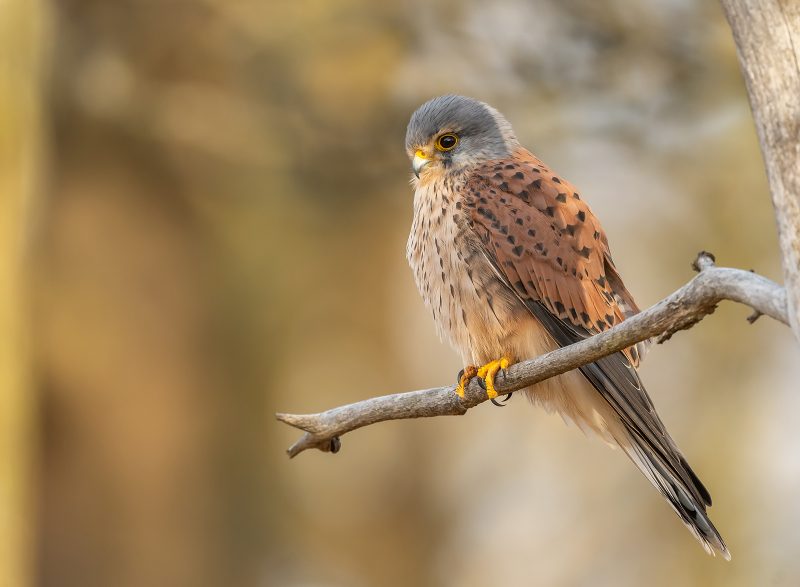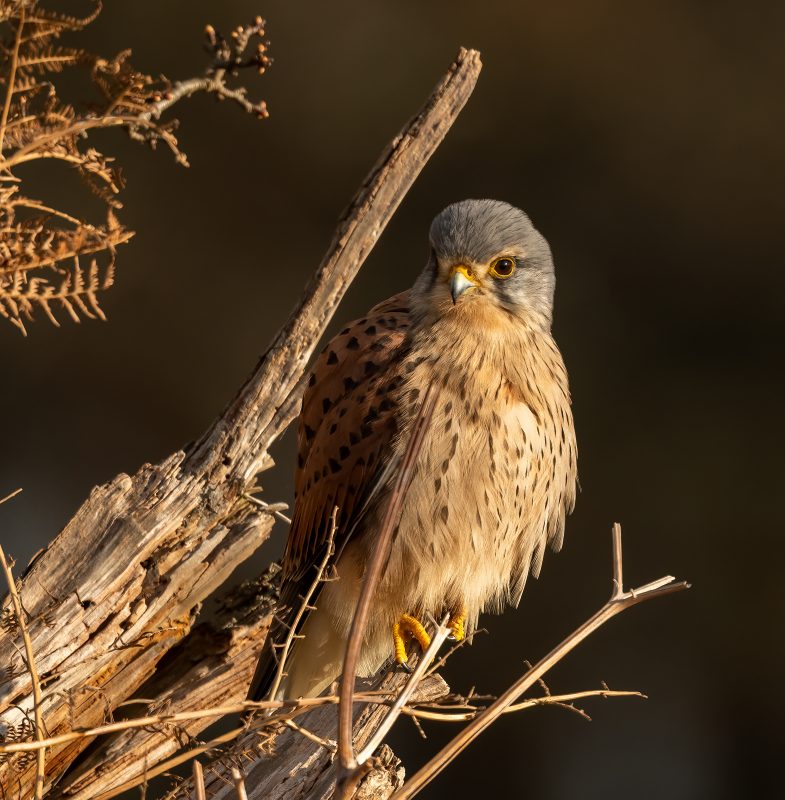How to Photograph Kestrels

I can safely say that kestrels are most likely my most photographed bird, and the bird I have spent the most time photographing over recent years. Not only that, they are right up there with my all-time favourites.
I think you can only come to appreciate how remarkable they are by observing them hunt: the way they wind hover in blowing gales is nothing short of a natural marvel, and the fact that they can see UV light in the urine of their prey is remarkable.


Distinguishing factors
When hunting, kestrels will typically quarter the area while surveying below. When they spot something of interest they stop and hover, and will gradually work the hover lower until they are in striking range. They will also sometimes hunt from perches, and ground hunt prey such as grasshoppers and lizards.
Male and female kestrels are sexually dimorphic and easily identifiable. Male kestrels have a grey/blue head, whereas females do not.
How to find kestrels
They once held the title of most common raptor here in the UK, which I believe has recently been taken by the buzzard. However, they are still relatively common. They are also incredibly adaptable and can call many habitats and landscapes home, as well as often taking to man-made boxes.
Read More: How to Find and Photograph Raptors
The first place to look for kestrels would be open countryside with meadows, grassland, hedgerows, and mature trees. They love to hunt in similar habitats to owls, and will sometimes steal prey from the far less agile barn owl.
However, unlike owls, they actively hunting during the day, which can make them far easier to photograph. Whilst out on walks in the aforementioned habitats, keep an eye out for kestrels hovering above the grass. Once spotted, they should be unmistakable.
Another great way to spot kestrels is to look on cliff sides, and I’ve had some great success with this. My preferred location is the Sussex coastline, which is home to a good few kestrels that nest in the chalk cliffs. This provides them with small, young seabirds to hunt below, as well as voles and mice in the the grassy meadows behind.
They are also safe here from land predators, and usually from human disturbance too. So, whilst walking along a cliff side or coastal walk, keep your eye out for the signature wind hover. They also often like to perch right on the edge of the cliff, watching the world (or potential prey) go by.
This setting will allow you to get low and slowly sneak up towards the kestrel (without getting too close to the edge, of course), and achieve some nice low-level shots. This type of location is by far my favourite, as it provides potential for some lovely backgrounds, foregrounds, and eye-level shots.
Read more: 6 Tips for Better Fieldcraft in Wildlife Photography
Various nature reserves can also be good places to find and photograph kestrels. I have found Elmley Nature Reserve in particular to be best. The kestrels there are very used to humans, and are quite comfortable posing on a fence post nearby, or hover-hunting right above your head.
Photographing kestrels
After you have put in the time and effort searching the areas I mentioned above (or perhaps just been incredibly lucky), you will want to invest time in photographing these stunning raptors.
In flight, kestrels are incredibly agile, quite small, and very, very quick. If you want a standard flight shot, you will need a fast shutter speed: I wouldn’t go below 1/1600s for this.
If you are fortunate enough to be photographing a kestrel hover-hunting relatively closely, you can use a high shutter speed (1/1600s+), but you also have the opportunity to try some creative shots with a lower shutter speed. This can achieve wing motion blur, which can be a pleasing and unique effect.
Aim for low apertures to get nice blurry, soft backgrounds. But for flight shots, if light allows and ISO doesn’t need to be pushed too high, you can stop down towards f/8 to deliver even more sharpness.
This is quite a rare scenario, but there are some top-quality pieces of software available nowadays, which can significantly reduce noise produced with higher ISO shots.
Read more: What are Shutter Speed and Aperture
One thing I would advise against is shooting straight up at a hover-hunting kestrel, into a white or cloudy sky. You will achieve far better shots if you either wait until the bird hovers lower (which they generally do if they are about to strike prey), or wait until some blue sky or a better background presents itself.
With this being said, one of my biggest pieces of advice is to get out there and take shots, lots of them, whatever the conditions or lighting. Practice makes perfect!
You don’t need an abundance of fieldcraft skills to photograph kestrels. I often find it’s more about putting the time and effort in to finding the right location, and then investing the hours. Kestrels can often be very happy with your presence, as long as you are quiet, slow-moving, and don’t push the limits.
Take your time and don’t rush up to the bird once you find it. Always make small, slow movements, making sure the kestrel is comfortable with you. A great tip is to stay low, get on your front, and make your profile as small as possible.
Finally, with regards to fieldcraft for kestrel photography, I highly suggest wearing dull, muted colours, such as green and brown, so you blend in and do not stick out. This is the case with most wildlife photography.
Equipment
I exclusively use a 500mm prime lens on a crop-sensor camera body (so actually closer to 750mm), and I would not recommend a focal length any shorter than this. Kestrels are small and generally far away, so they will not fill your frame unless you find a particularly obliging subject.
Something like a Sigma 150-600mm lens for starters, along with a DSLR or mirrorless camera that has continuous autofocus and a reasonable number of frames per second (my camera can do 10), will suffice as you are learning.
While tripods will offer you the most stability and allow sharper shots at a lower shutter speed, given the agility of kestrels I almost never use one, unless shooting video. By using a light 500mm prime lens I can be agile myself, get to the ground quickly, and easily adapt to their movements if necessary.
The number of shots I would have missed if I had to sit in a stationary position with a huge, exotic prime lens and tripod is unthinkable. It may be worth picking up a pair of binoculars, as they can be very handy when out walking and scouting locations.
Using binoculars is preferable to constantly looking down the viewfinder, which can be slightly cumbersome with a long lens!
In conclusion
Kestrels are fascinating birds and formidable hunters, and can provide excellent photographic opportunities all year round. Spend some time scouting and walking in the kinds of areas I mentioned above, and you will be sure to see one eventually.
If you are lucky enough to have access to suitable land, why not put up a kestrel box to help out your local population?

















